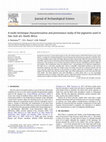Papers by Adelphine Bonneau
Résumé. Plusieurs sites nord-américains ont révélé perles, contenants et vaisselle de table, comm... more Résumé. Plusieurs sites nord-américains ont révélé perles, contenants et vaisselle de table, comme autant de témoignages matériels de l’implantation des Européens en Amérique du Nord à partir du XVIe siècle. Qu’il s’agisse d’implantations européennes temporaires, de sites relatifs aux premières tentatives d’implantation française ou de sites coloniaux plus tardifs, tous témoignent de réalités politiques, socio-économiques et commerciales spécifiques.Summary. Many glass beads, drinking glass and glass containers found in north American archaeological sites can be considered as an evidence of the French colonial period, dating from the 16th c. to the end of the French colonial period. From first European settlement to colonial sites, all the glass objects found in archaeological contexts show some specific political, socio-economic and commercial realities
HAL (Le Centre pour la Communication Scientifique Directe), Jan 4, 2023
Indigenous Heritage and Rock Art, 2021
Le Centre pour la Communication Scientifique Directe - HAL - Aix-Marseille Université, 2015
African Archaeological Review, 2021
This paper reports on the steps taken to mitigate the impact of the Metolong Dam (Lesotho) on the... more This paper reports on the steps taken to mitigate the impact of the Metolong Dam (Lesotho) on the rock art present within the catchment of its associated reservoir. Mitigation took four major forms: comprehensive survey and documentation, including both photography and tracing; pigment characterization and radiocarbon dating; exploration of the ongoing significance of rock art as a form of living heritage for people living in the vicinity; and removal of selected panels for permanent safekeeping. These steps are placed within the wider context of other cultural heritage management projects in Africa and their success evaluated. Recommendations are made for how similar work should be undertaken in future.

La lecture geoarcheologique des sediments peut permettre, dans des cas favorables, une etude micr... more La lecture geoarcheologique des sediments peut permettre, dans des cas favorables, une etude microchronologique des traces d’activites anthropiques. L’etude micromorphologique des foyers devient de plus en plus courante, mais il existe des biais dans l’enregistrement des evenements de paleo-feux dans les structures de combustion. Dans cette communication, nous presenterons une autre methode: la Fuliginochronologie, du latin fuliginosus, fuligo: suie, fuligineux/fuligineuse, et du Grec khronologia: chronologie, qui consiste a etudier la succession des depots de suie pieges dans une matrice. Nous ne developperons ici que les cas de suie pieges dans les depots carbonates et plus particulierement dans des speleothemes. Dans le cas particulier d’un site archeologique comme un abri-sous-roche ou une grotte, ces concretions (stalagmite, croute parietale, plancher) fuligineuses sont des archives enregistrant des occupations humaines passees, qui peuvent etre decomptees et dont le rythme de ...

Quaternary International, 2021
Recent research on Later Stone Age (LSA) San rock art in southern Africa has unveiled some of the... more Recent research on Later Stone Age (LSA) San rock art in southern Africa has unveiled some of the paint recipes the artists employed. However, these discoveries still need to be linked to human activities in or near the rock shelters where the paintings were made. In this paper, we report characterization and dating results from the catchment of the Metolong Dam, Phuthiatsana Valley, Lesotho. A total of 92 rock painting samples, six grindstones with traces of colouring materials from an excavated context, and 17 potential raw colouring materials were studied. We identified three previously unreported ingredients used by the artists: manganese oxides, calcined bones, and soot. Grindstones are stained with the same raw materials that the painters used. We propose that one of them may have served to prepare the red pigment used to make a human figure and a bichrome eland at Ha Makotoko, but direct links remain difficult to establish with certainty. The potential colouring materials in the valley are red clays, white clays (kaolinite and illite-or-montmorillonite), and gypsum, three compounds used as paints by the artists. Tests conducted to verify their suitability for paintings show these materials may have been ground, but settling (after pre-grinding) offers a quicker and easier way to obtain a fine powder as observed in the paints. Finally, 12 AMS dates provide an initial framework for studying the changing use of paint recipes in the Phuthiatsana Valley over time. Charcoal appears to have been employed over a period of at least 3000 years and carbon black for at least 2000 years, with soot seemingly used only before 2000 cal. BP. This study is currently the largest characterization and dating study of LSA rock art in southern Africa and shows the potential that such combined investigations offer for linking excavated and parietal components of the region's huntergatherer archaeological record.

Radiocarbon, 2016
Worldwide, dating rock art is difficult to achieve because of the frequent lack of datable materi... more Worldwide, dating rock art is difficult to achieve because of the frequent lack of datable material and the difficulty of removing contamination from samples. Our research aimed to select the paints that would be the most likely to be successfully radiocarbon dated and to estimate the quantity of paint needed depending on the nature of the paint and the weathering and alteration products associated with it. To achieve this aim, a two-step sampling strategy, coupled with a multi-instrument characterization (including SEM-EDS, Raman spectroscopy, and FTIR spectroscopy analysis) and a modified acid-base-acid (ABA) pretreatment, was created. In total, 41 samples were dated from 14 sites in three separate regions of southern Africa. These novel protocols ensure that the14C chronology produced was robust and could also be subsequently applied to different regions with possible variations in paint preparation, geology, weathering conditions, and contaminants.

Radiocarbon, 2011
The dating of South African rock art using radiocarbon is a considerable challenge and only 1 dir... more The dating of South African rock art using radiocarbon is a considerable challenge and only 1 direct date has so far been obtained, on black pigments from Sonia's Cave Upper, Boontjieskloof. The main problem with direct dating these paintings is the presence of calcium oxalates behind, on, and within the pigment layers. Calcium oxalates are formed through lichen and bacterial action on the rock face. These reactions can sometimes take place over long periods and can incorporate carbon of a younger age into the pigments. This study aims to date black pigments from a rockshelter, RSA TYN2 (Eastern Cape, South Africa), by removing the calcium oxalate contamination. Two different protocols were tried: density separation and acidification. The latter successfully removed calcium oxalates and was therefore applied to 3 black pigment samples from the rockshelter. After acid pretreatment, accelerator mass spectrometry (AMS) dating was undertaken on the remaining residues. Three results ...
Antiquity, 2017
Rock art worldwide has proved extremely difficult to date directly. Here, the first radiocarbon d... more Rock art worldwide has proved extremely difficult to date directly. Here, the first radiocarbon dates for rock paintings in Botswana and Lesotho are presented, along with additional dates for Later Stone Age rock art in South Africa. The samples selected for dating were identified as carbon-blacks from short-lived organic materials, meaning that the sampled pigments and the paintings that they were used to produce must be of similar age. The results reveal that southern African hunter-gatherers were creating paintings on rockshelter walls as long ago as 5723-4420 cal BP in southeastern Botswana: the oldest such evidence yet found in southern Africa.

Journal of Archaeological Science, 2012
During the course of a conservation project at the rock shelter known as RSA TYN2 (Eastern Cape, ... more During the course of a conservation project at the rock shelter known as RSA TYN2 (Eastern Cape, South Africa), a sample of 33 painted fragments that had become detached from the wall were collected. They have been studied using a multi-technique approach (optical microscopy, SEM-EDS, Raman spectroscopy and FTIR), with the aim of achieving a better understanding of their paint stratigraphy, composition, and provenance. The paintings are on a Clarens Formation sandstone and are embedded in calcium sulphates and oxalates. The red pigments show two different 'hues', corresponding to two different compositions. The light red is a red ochre, possibly pure, which is probably a degradation product of the Clarens Formation sandstone. The dark red contains more iron oxides and may be a mixture between the red ochre and pure haematite. Because of the presence of crystals which may be identified as augite we suggest this haematite came from the basaltic upper part of the Drakensberg, at least 4 km away from the rock shelter. The black pigments have been identified as carbon black, that is to say, incomplete combustion products of organic compounds, and are radiocarbon dated to between 2120 and 1890 cal BP, making these samples the oldest directly dated South African rock art.

Uploads
Papers by Adelphine Bonneau
In this poster, we will introduce a pioneer method for studying fire traces left by human groups in an archaeological site. This method is called Fuliginochronology, from Latin fuliginosus, fuligo: soot, fuliginous, and from Greek khrônologia: chronology. It consists of studying the succession of soot deposits trapped in a matrix. Here we will only develop the cases of soot trapped in carbonate deposits and more specifically in speleothems. In the particular case of an archaeological site like a rock shelter or a cave, these fuliginous calcite deposits (i.e. stalagmite, parietal crust, flowstones) are a record of past human occupations, which can be enumerated (Vandevelde et al. 2017; 2018; Vandevelde et Dupuis 2017). Rhythms of human occupations in a site can also be recorded. This pioneer method is based on high-resolution observation of soot layers trapped in calcite deposits and of the speleothems themselves, coupled with complementary analyses (only characterisation of soot by SEM and Raman analyses will be presented here). The poster will focus on an example in the Rhône Valley : the Grotte Mandrin, during glacial period, where fire use by Neanderthal is common on this site. References Vandevelde, S., Brochier, J.É., Petit, C., Slimak, L., 2017. Establishment of occupation chronicles in Grotte Mandrin using sooted concretions: Rethinking the Middle to Upper Paleolithic transition. Journal of Human Evolution 112: 70-78. https://doi.org/10.1016/j.jhevol.2017.07.016 Vandevelde, S., Brochier, J.É., Desachy, B., Petit, C., Slimak, L., 2018. Sooted concretions: A new micro-chronological tool for high temporal resolution archaeology. Quaternary International 474(B): 103-118. https://doi.org/10.1016/j.quaint.2017.10.031 Vandevelde, S., Dupuis, C., 2017. Voyage au bout de la suie. Chroniques des occupations humaines à la Grotte Mandrin [Ashes to ashes, soot to soot. Human occupations chronicles at Grotte Mandrin site], in : Cleyet-Merle, J-J., Shunkov, M.V., Le troisième Homme, Préhistoire de l’Altaï [The third Man, Prehistory of the Altaï], exhibition, Musée National de Préhistoire, Les Eyzies-de-Tayac, video : https://halshs.archives-ouvertes.fr/medihal-01580618